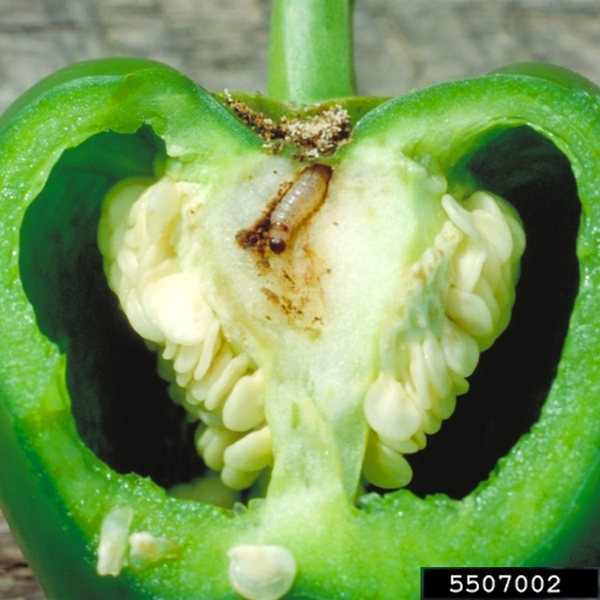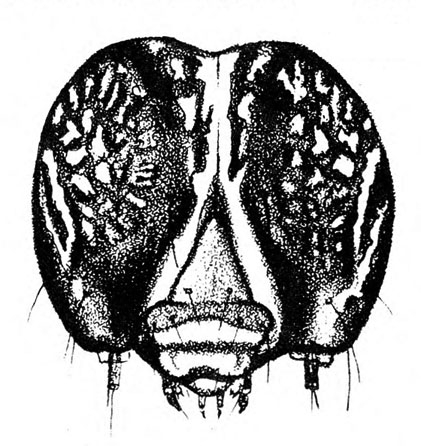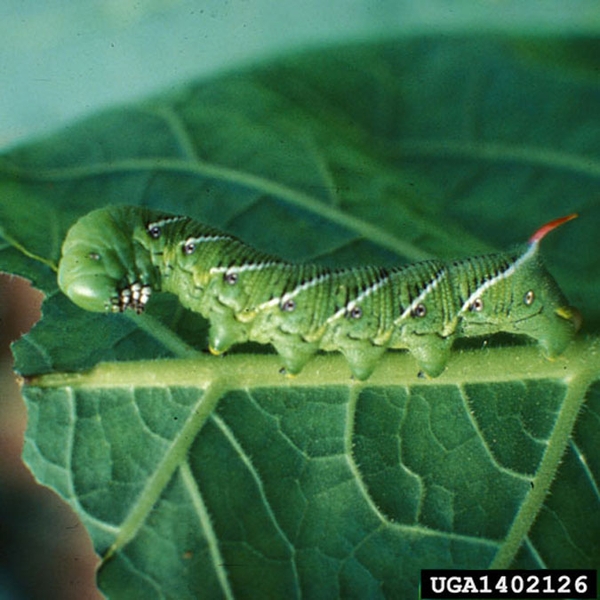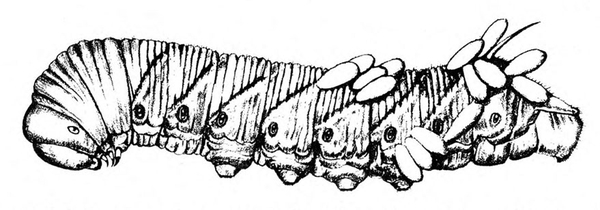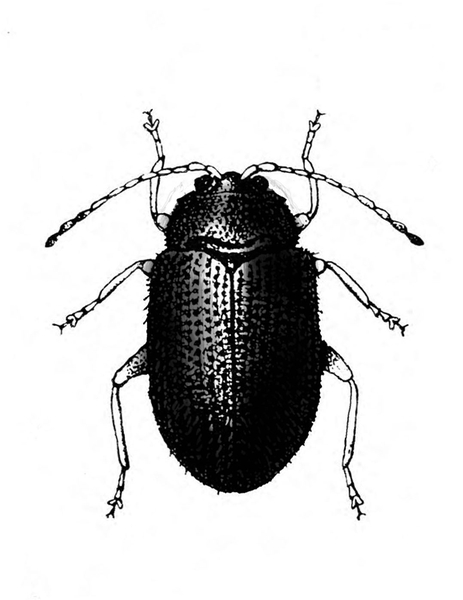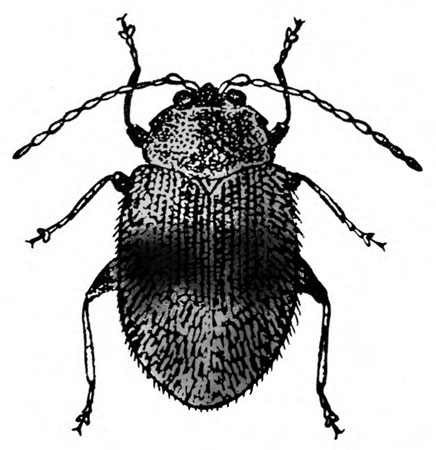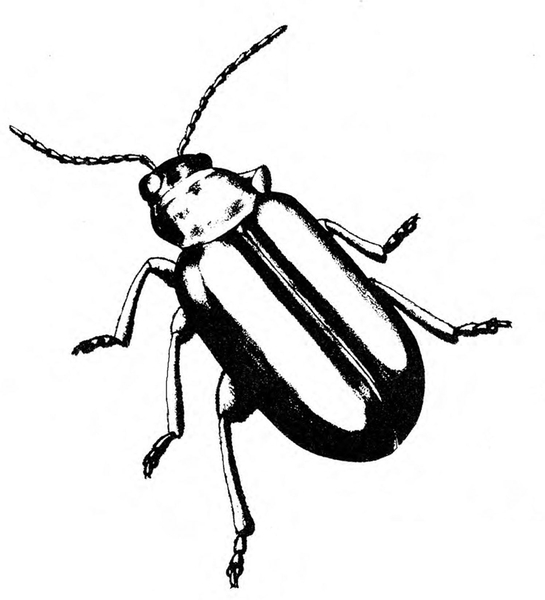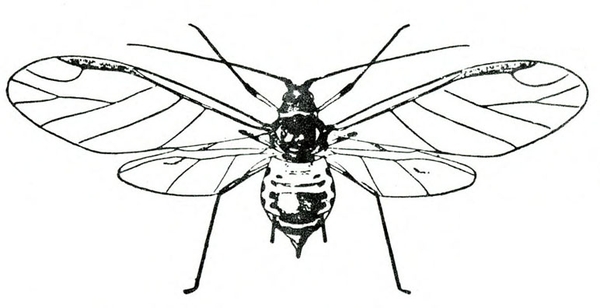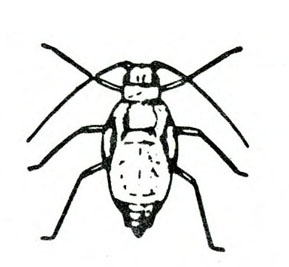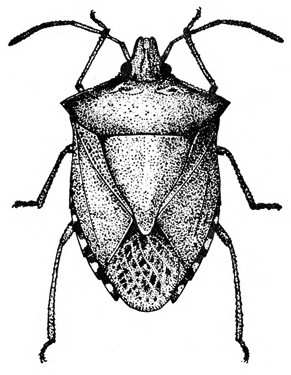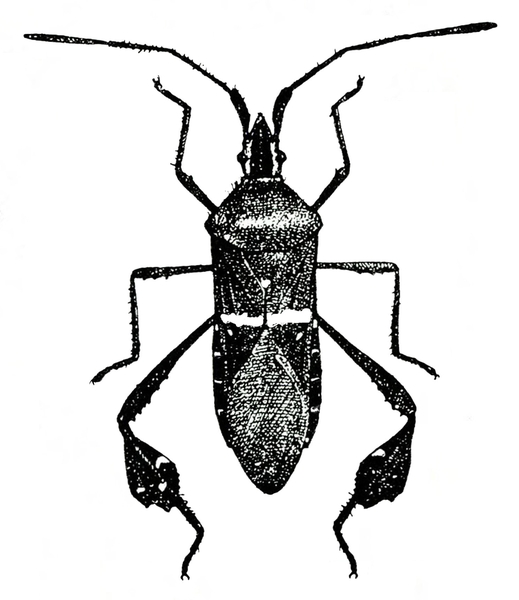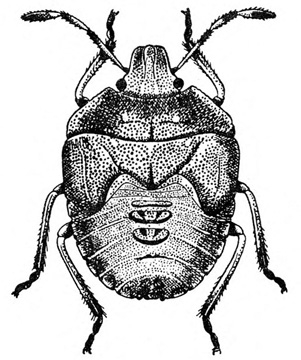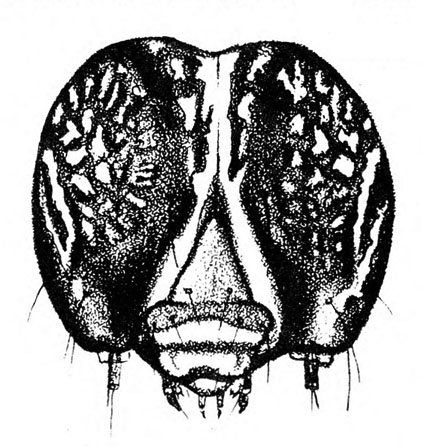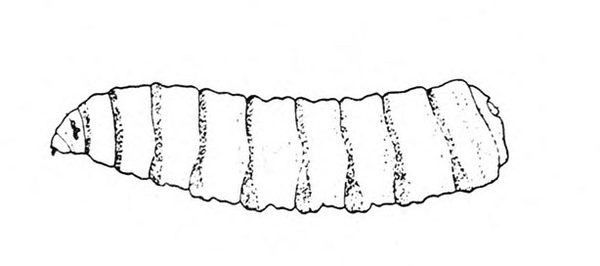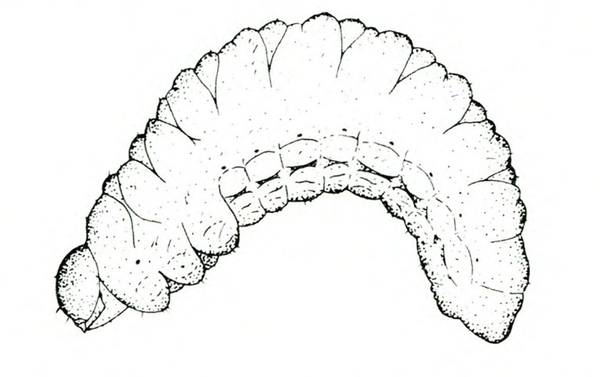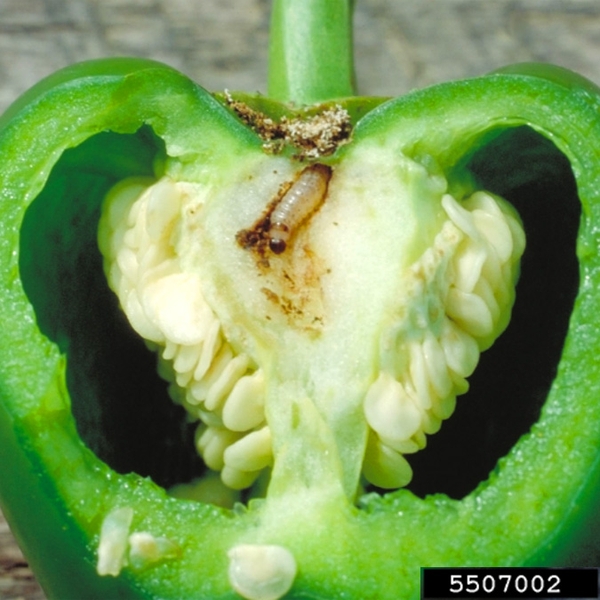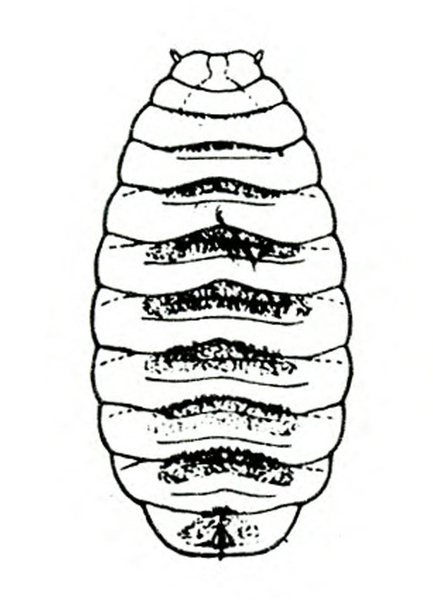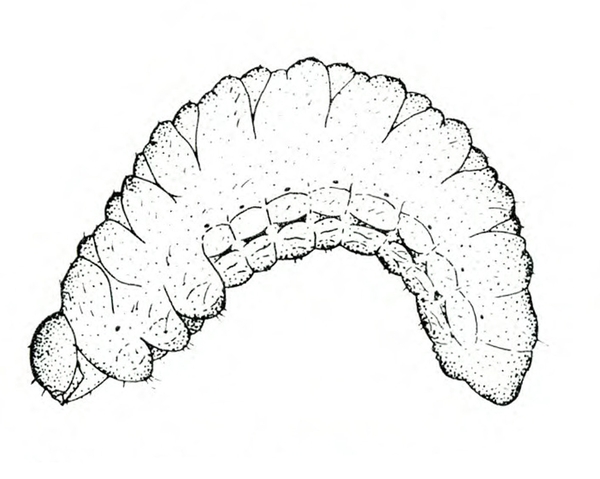More than 35 species of insects and mites are pests of peppers. Only twelve occur in North Carolina, however, and only seven are considered of economic importance, including the European corn borer, corn earworm, beet armyworm, fall armyworm, pepper maggot, green peach aphid, and tobacco hornworm. Flea beetles, cutworms, stink bugs and leaffooted bugs, potato leafhoppers, and pepper weevils are minor pests of peppers in North Carolina.
Insects damage peppers by feeding on foliage or fruit or by spreading viruses. Insects that feed within the fruit are of most concern to the processor.
Three critical periods exist for insect damage. By mid-June, aphids have usually established colonies in pepper fields. By early July, second generations of European corn borers, corn earworms, and pepper maggots are established. By early August, the most critical period, third-generation European corn borers, beet armyworms, and corn earworms can reach devastating levels unless a control program has been implemented.
- Insects that feed externally on plants
- Caterpillars
- Beet armyworm—These caterpillars are 1 3/16 inches long, soft-bodied, and green to black, with three light-colored stripes running the length of the body (Figure 1). There is a black spot on each side of the body on the second segment behind the head. Beet armyworms feed on buds and young leaves. (For more information about beet armyworms, see “Pests of Asparagus.”)
- Corn earworm (also known as tomato fruitworm)—The five to six larval instars vary considerably in color. Newly hatched larvae are about 1/16 inch long and yellowish white with dark head capsules. Second instars are yellowish green and frequently have orange and brown longitudinal stripes; their head capsules are reddish-brown to brown. Up to 1 3/4 inches long, later instars are greenish yellow, reddish, or brown, with pale, longitudinal stripes; raised, black spots (chalazae); and brown to orange heads (Figure 2). (For more information about corn earworms, see “Pests of Sweet Corn.”)
- European corn borer—The newly hatched larva, about 1/16 inch long, has a black head and a pale-yellow body bearing several rows of small black or brown spots. The borer develops through five or six instars to become a fully grown larva about 1 inch long (Figure 3). On most crops, including peppers, borers begin feeding on leaves and then bore into the fruit (Figure 4). (For more information about European corn borers, see “Pests of Sweet Corn.”)
- Fall armyworm—This green, brown, or black caterpillar has a black stripe down each side and a yellowish-gray stripe down the back. The body is up to 1 5/8 inches long (Figure 5A). It has three pairs of legs near the head and five pairs of prolegs. Its head capsule has a pale, but distinct, inverted Y (Figure 5B). This pest eats leaves and gouges fruit. (For more information about fall armyworms, see “Pests of Sweet Corn.”)
- Tobacco hornworm—This greenish caterpillar is as long as 3 1/2 inches with a red anal horn. The body has fine, white pubescence and seven diagonal stripes on each side (Figure 6A). Tobacco hornworms are sometimes found with cocoons of tiny parasitic wasps on their body (Figure 6B). This hornworm strips leaves and infrequently feeds on fruit, leaving large, open, superficial scars. (For more information about tobacco hornworms, see “Pests of Tomato.”)
- Beetles—These hard-bodied insects have wing covers that meet in a straight line down the middle of the back.
- Flea beetles—The potato flea beetle is 1/16 inch long and black (Figure 7A). The tobacco flea beetle is up to 1/8 inch long and reddish with a brown patch across the wing cover (Figure 7B). The palestriped flea beetle is 1/8 inch long and dark with a pale-yellow stripe along each wing cover (Figure 7C). These tiny beetles chew small, round holes in pepper foliage. (For more information about flea beetles, see “Pests of Potato.”)
- Pepper weevil—This reddish-brown to black “snout beetle” has a brassy luster. It has a body about 1/8 inch long and a spur on the inner side of each front leg (Figure 18A). It chews holes in foliage, buds, and tender pods.
- Insects that suck sap or juices from peppers
- Green peach aphid—This soft-bodied, pear-shaped, yellow to green to pink insect is almost 1/8 inch long, with a pair of dark cornicles and a short "tail" (the cauda) protruding from the abdomen. It may be winged (Figure 8A) or wingless (Figure 8B), though the wingless forms are more common. The winged adult has a dark dorsal blotch on its yellowish-green abdomen. The cornicles are more than twice as long as the cauda and slightly swollen toward the tip. The yellow-green nymph (Figure 8C) has three dark lines on the abdomen. The aphids cause discoloration or mottling of the foliage, transmit viruses, and excrete honeydew on which sooty mold grows. (For more information about green peach aphids, see “Pests of Lettuce.”)
- Potato leafhopper—This spindle-shaped pest grows up to 1/8 inch long and has a green body with yellowish to dark-green spots (Figure 9). It usually jumps instead of flies. It extracts sap from the undersides of leaves, causing them to crinkle, curl, and turn yellow. (For more information about potato leafhoppers, see “Pests of Potato.”)
- Stink bugs and leaffooted bugs—These bugs may be up to 3/4 inch long. Adult stink bugs are green or brown and shield-shaped (Figure 10A). Leaffooted bugs (Figure 10B) are brown with wide, flat legs. Stink bug nymphs (Figure 10C) are pale-green or green with orange-and-black markings. Leaffooted bug nymphs (Figure 10D) are mostly red. These bugs pierce buds, pepper pods, and seeds, causing pods to be deformed and seeds to be shriveled; wartlike growths appear on pods. (For more information about stink bugs and leaffooted bugs, see "Pests of Okra.")
- Chewing insects that mine leaves or bore into fruit
- Corn earworm (also known as tomato fruitworm)—Early instars (larval stages) are cream colored or yellowish green with few markings; later instars are green, reddish, or brown with pale, longitudinal stripes and scattered black spots. They are moderately hairy, up to 1 3/4 inches long, and have three pairs of legs and five pairs of prolegs (Figure 11). They sometimes bore holes in peppers. (For more information about corn earworms, see “Pests of Sweet Corn.”)
- Fall armyworm—This previously described pest (Figure 12A and Figure 12B) eats leaves and gouges fruit. (For more information about fall armyworms, see “Pests of Sweet Corn.”)
- Pepper maggot—This white, translucent, legless maggot grows up to 1/2 inch long and has a tapered head (Figure 13). It feeds inside fruit. Infested peppers have 1/64-inch egg punctures and turn red prematurely.
- Pepper weevil larva—This grayish-white, cylindrical, slightly curved, legless grub is up to 1/4 inch long and has a pale-brown head (Figure 14). It feeds at the seed core of peppers or tunnels into walls. The inside of an infested pepper becomes black and filled with frass (excrement).
- Insects that bore into or sever stems
- Cutworms—Several species of fat, basically gray, brown, or black caterpillars attack peppers. They are 1 5/8 to 2 inches long when fully grown, with three pairs of legs and five pairs of prolegs (Figure 15). They occasionally feed aboveground when young; older larvae burrow in soil during the day and sever plant stems at night. They curl up when disturbed. (For more information about cutworms, see “Pests of Asparagus.”)
- European corn borer—A cream-colored to light-pink caterpillar with a reddish-brown to black head, its body is up to 1 inch long with several rows of dark spots. It has three pairs of legs near the head and five pairs of prolegs (Figure 16). It bores into stems, leaving tangled frass and secreted silk near the entrance hole. Stems break, or plants wilt readily. Young larvae sometimes feed under the fruit cap and later bore into the fruit (Figure 17).
Pepper Maggot
Zonosemata electa (Say), Tephritidae, DIPTERA
Description
Adult—The adult pepper maggot is a yellow, orange, or brown fly about 5/16 inch long (Figure 18A). It has one pair of brown-banded, clear wings. The thorax has a median yellow line surrounded by a yellow “horseshoe.” A small, black dot is present on each side of the last abdominal segment.
Egg—The white, crookneck-shaped egg is a little more than 1/16 inch long (Figure 18B).
Larva—White and translucent when newly hatched, the maggot (Figure 18C) has a tapered head and turns yellow as it develops. When fully grown, it is 3/8 to 1/2 inch long and about 1/8 inch in diameter at its widest point.
Puparium—The pupa is enclosed in a hard covering known as the puparium (Figure 18D). This protective case is about 5/16 inch long and almost 3/16 inch wide.
Biology
Distribution—From New Jersey, this introduced pest has spread throughout the eastern half of the United States. It now occurs from Massachusetts south to Florida and westward to Indiana, Oklahoma, and Texas.
Host Plants—Pepper maggots feed within the fruiting structures of weeds such as horsenettle and ground cherry. Economically important hosts include hot cherry pepper, eggplant, and tomato fruit. Bell and sweet peppers are not preferred hosts.
Damage—The first sign of pepper maggot infestation is the appearance of egg punctures in peppers 3/8 to 1 5/8 inches in diameter. These punctures are elliptical holes 1/64 inch across. As infested peppers enlarge, the egg punctures become shallow depressions in the fruit. Maggots feed within the fruit, but they usually have emerged by the time the peppers are marketed. If peppers are picked when green, infested fruit may not be distinguishable from good fruit. Eventually, however, maggot-damaged peppers turn red prematurely and begin to rot. As they rot, peppers attract many kinds of flies, and other kinds of maggots may develop in the decaying fruit. These maggots should not be confused with the pepper maggots that initiated the damage; by the time rot sets in, the pepper maggots have already emerged from the pod and dropped to the soil to pupate.
Life History—Pepper maggots overwinter as pupae 2 to 4 inches below the soil surface. Flies emerge from late June through August and mate. Soon afterward, females insert eggs just beneath the skin of young peppers. Eggs hatch about 10 days later, depending on the growth rate of host peppers; at this time, the peppers are usually two-thirds to fully grown. Larvae feed within the peppers for about 18 days. When fully grown, each larva cuts an exit hole, emerges, and drops to the soil to pupate. Only one generation occurs each year.
Control
Insecticides are the only reliable method of pepper maggot control. Apply a dust or spray to the foliage when flies appear and repeat as necessary. For chemical control recommendations, consult the North Carolina Agricultural Chemicals Manual.
Pepper Weevil
Anthonomus eugenii Cano, Curculionidae, COLEOPTERA
Description
Adult—About 1/8 inch long, this reddish-brown to black “snout beetle” has a long, curved beak (Figure 19A and Figure 20A–C). The body is covered with yellowish and gray scale-like setae that give the beetle a brassy luster. A spur is located on the inner side of each front leg.
Egg—The oblong-oval egg is about 1/32 inch long. It is white when first deposited but gradually turns yellow.
Larva—When newly hatched, the legless larva is white and almost 1/16 inch long. As it develops, the grub becomes grayish white with a pale-brown head and darker mouthparts. When fully grown, the cylindrical, somewhat curved larva is about 1/4 inch long (Figure 19B and Figure 20A–C).
Pupa—White when newly formed, the pupa darkens as it matures. It is 1/8 to almost 3/16 inch long. It has short bristles on the back of its head, prothorax, and abdomen (Figure 19C and Figure 20A–C).
Biology
Distribution—From Mexico, the pepper weevil has spread to Texas, New Mexico, Arizona, California, Florida, and Georgia. Infestations in the Carolinas and Georgia usually happen when weevils are inadvertently transported on plants bearing small fruits or on picking sacks from areas such as Florida. This pest is occasionally found farther north.
Host Plants—Pepper weevils and their grubs can develop on black nightshade, eggplant, and bell, sweet, pimento, tabasco, and chili peppers. Though weevils feed on the foliage of several other weeds and crop plants, they do not lay eggs or develop on them.
Damage—The weevils feed externally on foliage, blossom buds, and tender pods. They do not cause as much damage as their grubs, however, which feed within buds and pods. Infested buds and blossoms fall from plants. The larvae usually feed at the seed core, but occasionally tunnel into the walls of pods. Infested peppers turn black inside and fill with frass. Infestations usually are not noticed until the stems of young peppers yellow and wither, causing the fruit to drop. By the time a few fallen pods are noticed, serious damage has occurred, and many more pods can be expected to fall in the following 10 days. Some infested pods turn red or yellow prematurely and may become malformed before dropping to the ground.
Life History—Pepper weevils spend the winter on live pepper or nightshade plants in warm areas of Southern California, Texas, and Florida. They spread from their overwintering sites each spring by flying or hitchhiking on pepper plants, picking sacks, or fruit on its way to market. The specifics of its life history have not been studied in North Carolina, so the following information is based on the weevil's biology in Florida.
Pepper weevils complete one or two generations on black nightshade weeds in early spring. They migrate to pepper as soon as plants become available. By June, weevils usually are feeding and laying eggs. Females chew holes in buds and fruit, place eggs within them, and seal the holes with brownish fluid. Each female deposits about 200 eggs over a 30-day period. Depending on the temperature, eggs incubate in three to five days.
Grubs bore into pepper pods and feed for about eight to ten days. At this time, full-grown larvae create cells made of frass within peppers and pupate. Four to six days later, a new generation of beetles emerges. This two- to three-week life cycle is typical in summer. In cool weather, however, five to six weeks may elapse between the egg and adult stage. In Florida, five to eight generations are produced each year.
Control
The chance of an infestation can be reduced by not buying pepper plants grown in areas where the pepper weevil is a problem. Cultural practices help control weevil populations in areas where this pest is common and lives year-round; however, such measures are of no benefit in North Carolina because the weevil cannot overwinter here. For up-to-date chemical recommendations, consult the North Carolina Agricultural Chemicals Manual.
Other Resources
General
Bessin, R. Common Insects Attacking Peppers. ENTFACT-301. University of Kentucky College of Agriculture, 2019.
Boswell, V. R., et al. Pepper Production, Disease, and Insect Control. Farmers' Bulletin 2051. USDA, 1959.
Pepper Maggot
Ghidiu, G. Pepper Maggot. Fact Sheet. New Jersey Agricultural Experiment Station, Rutgers Cooperative Extension, 2006.
Peterson, A. The Pepper Maggot, A New Pest of Peppers and Eggplants (Spilogmpha electa Say), Trypetidae. Bulletin 373. New Jersey Agricultural Experiment Station, 1923.
Phillips. V. T. The Biology and Identification of Trypetid Larvae (Diptera: Trypetidae). Memoirs of the American Entomological Society, no. 12 (1946).
Pepper Weevil
Burke, H. R., and R. E. Woodruff. The Pepper Weevil (Anthonomus eugenii Cano) in Florida. Entomology Circular No. 219. Florida Department of Agriculture and Consumer Services, Division of Plant Industry, 1980.
Elmore, J. C. The Pepper Weevil. Technical Bulletin 447. USDA,1934.
Elmore, J. C., and R. E. Campbell. The Pepper Weevil. Leaflet 226. USDA, 1956.
Goff, C. C., and J. W. Wilson. The Pepper Weevil. Bulletin 310. Florida Agricultural Experiment Station, 1937.
Publication date: June 12, 2024
AG-295
Other Publications in Insect and Related Pests of Vegetables
N.C. Cooperative Extension prohibits discrimination and harassment regardless of age, color, disability, family and marital status, gender identity, national origin, political beliefs, race, religion, sex (including pregnancy), sexual orientation and veteran status.




